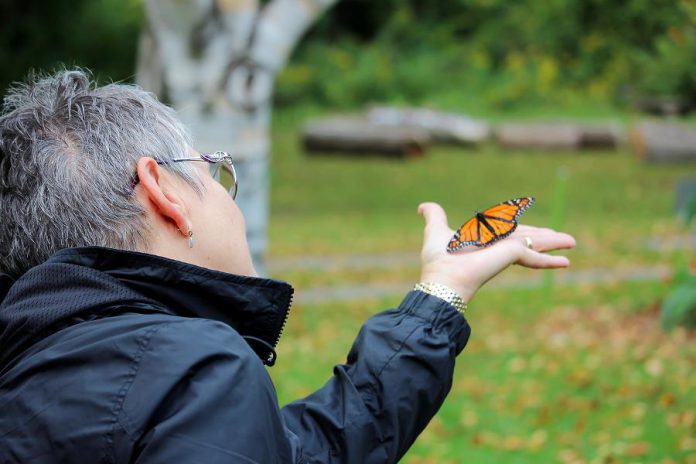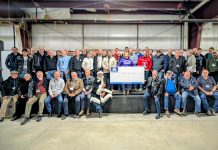
Fiery leaves falling through the autumn air are a familiar sight in Ontario. If you’re watching closely, you may notice the flutter of monarch butterflies among the colourful leaves. They are embarking on their 4000-kilometre migration. Cooling temperatures and shorter days signal the beginning of their long flight towards the Transvolcanic Mountains of Mexico.
Late this summer, participants of the GreenUP monarch butterfly workshop collected monarch larvae, in partnership with Kawartha Land Trust. These larvae are the offspring of monarchs that migrated to Ontario earlier this spring, from three or four generations of monarchs migrating back up north from Mexico.
The larvae were cared for at the GreenUP Store and were supplied with a healthy diet of the monarch’s host plant, fresh milkweed. Larvae cycled through their developmental stages, each one changing into a chrysalis, then emerging as an adult butterfly. Butterflies were then fed a sugar solution each day and were visited by many curious community members who were mesmerized by the fascinating life cycle of the monarch.

On September 19th, the butterflies were brought to GreenUP Ecology Park where Marcy Adzic, Manager of Landscape Programs, Marcy led the monarch tag and release event — inviting the community to participate and learn about the biology of the monarch butterfly and the current environmental challenges they face today. Attendees were also able to participate directly with two university citizen science programs that focus on tagging and parasite testing.
The final step was to release the monarchs at GreenUP Ecology Park. It is this single generation of monarchs that must successfully migrate back to Mexico in order to ensure the species’ survival.
How do they get there and what do they face along the way? That’s what the scientists behind Monarch Watch would like to know.
Monarch Watch is a non-profit program based out of the University of Kansas that maintains a database of information collected through volunteer tagging of butterflies by organizations such as GreenUP.

The tags are small, adhesive stickers placed on the butterfly wing that contain an ID number and contact information. When a tagged butterfly is found, the retriever can contact Monarch Watch and provide its location. This data is then used to understand migration routes, survival rates, and to help determine if these two things are affected by weather or climate change.
Monarchs face many challenges on their long migration routes. One hazard is infection by parasites, which can weaken the butterfly. To help understand more about this parasite-host interaction, participants collected scale samples from tagged butterflies, which were then sent to the University of Georgia for further study.
In addition to parasite infection, monarchs face some other hazards. Marcy Adzich explains that here in Ontario, dog-strangling vine (an invasive plant) is invading areas where milkweed usually thrives. Monarchs have been shown to mistakenly lay eggs on dog-strangling vine rather than on milkweed, which is proving to be toxic to emerging larvae who die after consuming the leaf.

According to Monarch Watch, the best way to ensure that these majestic insects continue to thrive is to ensure that monarchs have a healthy habitat here in Canada where they spend the summer, in Mexico in their overwintering grounds, and along their migration routes.
GreenUP is encouraging us to all be monarch stewards by helping to make Peterborough a community that hosts healthy habitat for butterflies.
We can work together to create, conserve, and protect monarch habitats right here in our own backyards by planting and encouraging milkweed growth as well as flowering nectar plants from early spring to late fall, which adult butterflies require for energy to survive the long flight.
To find out more about how you can help monarchs, please visit www.monarchwatch.org or email Marcy Adzich, Manager of Landscape Programs at GreenUP, at marcy.adzich@greenup.on.ca.


























